
Sometimes I wonder where 1984 went
Sitting across the dinner table from my parents
Frozen
Me stuck at the age of 1
The annihilation of my mind
I touch my long braid to make sure it’s still there
My brothers dressed as girls to pass through another village for safety
Terror rises
And I dance
Making ancient sounds with my body
Slapping my heels against bare earth
Raising my arms then spinning
I look down at dirty red brown
You will be walking in memory of twenty-eight-year-old Darshan Singh who was a young farmer from Amritsar district. On 9 September 1990, Darshan and two other young men went for a motorcycle ride when a group of police officers suspected them of being militants and shot at them. Darshan, the pillion rider, was hit by a bullet and fell down dead. The police took Darshan’s two companions into custody and reported them dead in alleged encounters.
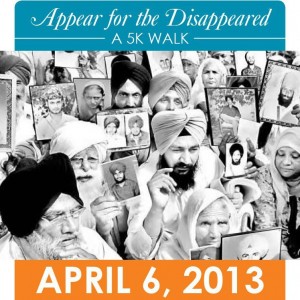 After recently registering for Ensaaf’s Appear for the Disappeared 5K walk, I received the above email with information about the individual in whose memory I would be participating.
After recently registering for Ensaaf’s Appear for the Disappeared 5K walk, I received the above email with information about the individual in whose memory I would be participating.Ensaaf has documented thousands of cases of disappearance and unlawful killings in Punjab and in an effort to allow its supporters to connect with victims, Ensaaf is holding a 5k walk, called Appear for the Disappeared, on April 6, 2013 in Fremont, CA. The walk is an opportunity for all participants and virtual donors to commemorate a specific individual who was disappeared in Punjab by Indian security forces from the mid-1980s to late 1990s. Ensaaf’s goal is to commemorate 500 individuals and raise $25,000 to complete documentation efforts.
Between 1984 and 1995, Punjab witnessed thousands of disappearances and unlawful killings, with many victims facing unimaginable torture at the hands of Indian security officials. Rarely were victim families informed of the fate of their loved ones, let alone given a chance to carry out final rites and funeral services. As thousands of men and women disappeared and their families left in the darkness, responsible security officials were awarded promotions and their human rights violations faded into darkness.
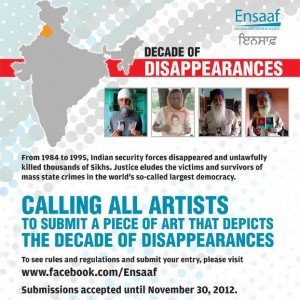 Following the assassination of Prime Minister Indira Gandhi in 1984, the Indian government employed orchestrated pogroms against Sikhs. Mobs, equipped with weapons, kerosene, and the addresses of Sikh homes, chanted “khoon ka badla khoon se lenge! (Blood for blood)” as they hunted innocent Sikhs, and those protecting Sikhs, throughout Delhi. Suddenly, Sikh Indian citizens were left stranded in their homeland with no protection and no exercise of control by the Indian government.
Following the assassination of Prime Minister Indira Gandhi in 1984, the Indian government employed orchestrated pogroms against Sikhs. Mobs, equipped with weapons, kerosene, and the addresses of Sikh homes, chanted “khoon ka badla khoon se lenge! (Blood for blood)” as they hunted innocent Sikhs, and those protecting Sikhs, throughout Delhi. Suddenly, Sikh Indian citizens were left stranded in their homeland with no protection and no exercise of control by the Indian government.
“Murderous gangs of 200 or 300 people led by leaders, with policemen looking on, began to swarm into Sikh houses, hacking the occupants to pieces, chopping off the heads of children, raping women, tying Sikh men to tires set aflame with kerosene, burning down the houses and shops after ransacking them. Mobs stopped buses and trains, in and out of Delhi, pulling out Sikh passengers to be lynched to death or doused with kerosene and burnt alive. In some areas, the Sikh families grouped together for self-defense. The police officials then arrived to disperse them, by force when the persuasion did not work. In other areas, the police searched the houses for weapons including ceremonial daggers, and confiscated them before the mobs came. Over the next five days, nearly 3,000 Sikhs were killed.” -Reduced to Ashes, pg. 42
Guest blogged by @NSYF (National Sikh Youth Federation)
 The Sikh community in the UK is once again preparing to mark the anniversary of the June 1984 Indian army invasion of their holiest place of worship. Harmandir Sahib, also known as the Golden Temple located in Amritsar, was invaded in an unprecedented Indian army action against the civilian population that resulted in massive casualties and wide spread human rights violations.
The Sikh community in the UK is once again preparing to mark the anniversary of the June 1984 Indian army invasion of their holiest place of worship. Harmandir Sahib, also known as the Golden Temple located in Amritsar, was invaded in an unprecedented Indian army action against the civilian population that resulted in massive casualties and wide spread human rights violations.
Every year for the past 27 years the UK Sikhs have been gathering in Hyde Park London for a protest march that ends with a rally in Trafalgar Square. This year is no exception with the rally taking place on the 10th of June. The rally makes vocal the Sikh demands for justice and has been seen as a show of solidarity and remembrance.
As times have changed and the Sikh diaspora have become more educated and media savvy, their methods of protest have also evolved. Young Sikhs have come together to found a charitable NGO and Think Tank called the National Sikh Youth Federation (NSYF). This organisation, whose motto is ‘To Educate, Inspire and Unite’ has become the platform for an innovative media campaign to highlight the events of June 1984. Utilising both social and physical media NSYF are attempting to create mass awareness. From the 1st to the 10th of June NSYF will be uploading one picture everyday at 0700 GMT via their twitter account @theNSYF centred around the hashtag #10DaysofTerror.
NSYF will be telling the story of June 1984 by recreating the major events of each day with a historic newsfeed, culminating in the release of a video to tie the campaign together.
UPDATED: All of a sudden I remembered a video from KPS Gill. Readers on this site are aware of this murderous sadist, but maybe it is still worthwhile to juxtapose his lies with the findings announced this week.
All of our attention shifted towards Punjab last week. There was some interesting developments early this week. One is that Voices for Freedom, a non-government organization, based out of Punjab filed a public interest litigation (PIL) petition against the Sukhbir Badal’s appointee for Director General of Police (DGP) Sumedh Saini. Saini is a well-known human rights abusers and was involved in the many murders, “disappearances”, and torture during the 1980s and 1990s. From the media reports, while the petition may not go far, hopefully it does center some more attention on just the type of thugs that the the Badal Mafia appoints.
Another note from Punjab came yesterday when the National Human Rights Commission (NHRC) of India announced that they would pay Rs. 175,000 (about $3,500) to 1,500 families in the Amritsar district for the murder of their sons. Of course there is no culpability, just an attempt to buy silence. Well-known human rights lawyer Navkiran Singh of Chandigarh has rightly state:
It is too little too late and why only from Amritsar District? Khalra gave example of Amritsar district, but wanted an inquiry for the whole of Punjab. Imagine we had to pursue the matter in the NHRC for 17 years for this little justice.
UPDATE: I just wanted again to stress the lies that KPS Gill has restated for years. See this interview with an Australian journalist, when asked point-blank about the case of illegal cremations, KPS Gill lies without hesitation. Contrast this where the NHRC admits it occurred and even pays out money to families, though without casting any blame or responsibility. I have yet to see a true Indian journalist expose KPS Gill for his lies. Unfortunately they continue to lionize him, assuring that impunity continues – whether in Punjab, Delhi, Gujarat, Kashmir, and many other regions of South Asia.

 The following is a guest-post, In Defence of Assassination: Balwant Singh Rajoana’s Gift to the Nation, by our guest-blogger Inklabi Singh.
The following is a guest-post, In Defence of Assassination: Balwant Singh Rajoana’s Gift to the Nation, by our guest-blogger Inklabi Singh.
Balwant Singh Rajoana has been in jail since 1995 and was sentenced to death 5 years ago, but it was only recently, as the date of his execution started to loom closer, that a wave of indignation and concern swept over the Khalsa Panth, both in Punjab and the Diaspora. As others have written, this is a spontaneous response to the power of a Sikh fully in love with his Guru and Panth, completely at ease with the will of God and unequivocally unafraid of death. This popular movement leaves many of us in a predicament though. The dilemma we face is that we are socialized to view acts of violence as inherently immoral. How then are we able to express love for an individual who planned and helped carry out the suicide bombing of an unarmed old man? Balwant Singh’s case puts us in an uncomfortable position. Can we defend assassination? Can the killing of unarmed officials be justified? Are such acts true to Guru Nanak’s vision of compassion and respect for diversity?
Many have been asking why the Indian government attacked Sikhs in 1984 in the first place. How did we reach a point that Balwant Singh felt he had no choice but to assist in the killing of Chief Minister Beant Singh in August of 1995? We can go through the history of South Asia and clearly delineate the path from the Independence struggle, through Punjabi Suba and Emergency to the Amritsar Massacre of 1978, but the short answer is a simple one. It is the same reason the British tied Sikhs to cannons in 1885, the Mughals executed 200 Sikhs a day for weeks in the courtyard of the Red Fort in Delhi in 1716 and why Guru Arjan was burned alive for five days in Lahore four hundred years ago. It is because we did what Guru Nanak compelled us to do, to speak truth to power and not be silent in the face of tyranny just as he did when he condemned Babur the Mughal’s invasion of India. That act, enshrined in Guru Granth Sahib jee, of standing with the oppressed against the oppressor, has led to generations of Sikhs putting the principles of freedom and human rights above their own safety and wellbeing.
This is never a fair fight. The oppressor controls vast resources and commands huge armies that dwarf our meagre numbers. This was true when Guru Gobind Singh’s forty Sikhs held off the entire Northern army of the Mughal Empire at Chamkaur for a long cold and wet night in December of 1705 and it was true when Baba Jarnail Singh and his band of a few hundred young men and women stood like a mountain against the technological might of the Indian army for a long, sweltering week in June of 1984. We will always be the minority for we take the uncomfortable, unpopular and dangerous position; we forsake the riches of collusion and collaboration for the principle of equality and justice, even if it means a tortured death.
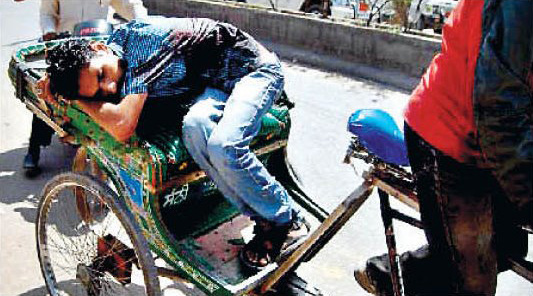
It has now been confirmed by Navkiran Singh, well-known human rights advocate and a lawyer for Bhai Balwant Singh Rajoana, that Ranjeet Singh is in critical condition, but is alive. Our apologies for the incorrect information, but one can understand that with information from Punjab being limited, details are being lost.
Yesterday I wrote about Jaspal Singh, whose loss became well-circulated, due to social media and the outstanding work of Sangat TV and the Sikh Channel.
A very young Ranjeet Singh Mandher, only 16 years old, son of Jaswinder Singh, from village Pandher (Mukerian road) was shot by police. With the heavy police fire, no one came to help him. The veer had to take his own rickshaw to the hospital. From there the hospital in Gurdaspur sent him to Amritsar, where he is in stable condition. I am including the only picture I have received of the youth. If others can provide more information about this young student, please do send it to us.
In other news, Bibi Kamaljeet Kaur was not allowed to meet the family of Jaspal Singh in Gurdaspur. She was stopped on orders from the government. Such is the government of Badal, where police offers open fire and underlings can only be suspended. It only follows the logic of one that would promote a murderer as Sumedh Saini as DGP and give coveted MLA seats to the wife of a butcher like Izhar Alam. The Punjab Government fears Bibi Kamaldeep Kaur and are trying to limit her movement. At present, she is still giving interviews on Sangat TV and other media outlets. Sangat TV has a livestream that can be seen here as does the Sikh Channel, which can be seen here.
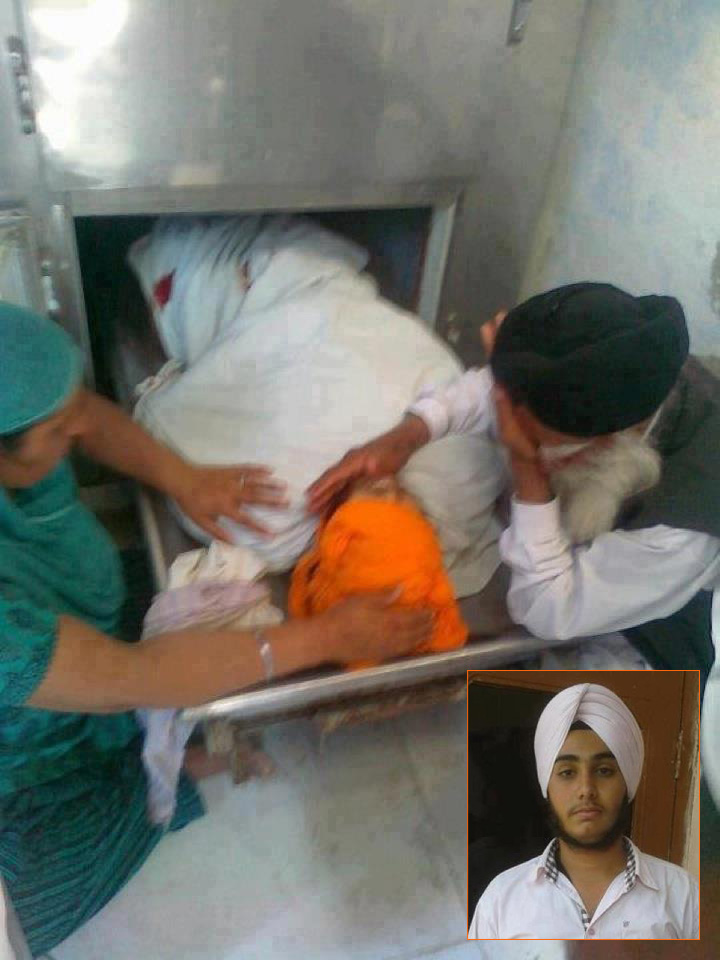 Details are murky, so to do a full analysis at this point is difficult. Right now, we stand to document the events. According to numerous reports, Shiv Sena from mainly Gujarat and Maharastra are entering Punjab. Gurdaspur has been a long-time stronghold of the Shiv Sena as well. Those that are arriving seem to be arguing that if Sikhs could shut down the state yesterday that they would be able to do it today. Read here from our live-blogger from Amritsar that shares much of the same information.
Details are murky, so to do a full analysis at this point is difficult. Right now, we stand to document the events. According to numerous reports, Shiv Sena from mainly Gujarat and Maharastra are entering Punjab. Gurdaspur has been a long-time stronghold of the Shiv Sena as well. Those that are arriving seem to be arguing that if Sikhs could shut down the state yesterday that they would be able to do it today. Read here from our live-blogger from Amritsar that shares much of the same information.
At Gurdaspur this morning, Jaspal Singh, a young 18 year old Sikh boy from Chor Sidhvan village, was killed by police firing. Below the tab you can find an eye-witness video of how the Sumedh Saini’s rogue police has differential treatment towards the Sikh youth and the out-of-state-arriving Shiv Sena. Remember it was Sukhbir Badal, the so-called heir apparent, that personally chose this known human rights abuser to be the Director General of Police. Murders are lauded in Punjab. It was this same Badal that ran for election the wife of the one of the worst butchers of Punjab – Farzana Alam. Farzana’s husband, Izhar Alam, ran his own crack team, called the “Alam Sena” that would give criminals unlimited powers to run wild. His own atrocities are stunning. Eye witness accounts describe his atrocities on women and his summary executions. These are our new “leaders” of Punjab installed by Badal

 Day 2, March 29: Day after 1st Punjab Bandh
Day 2, March 29: Day after 1st Punjab Bandh
I tend to spend my nights at the Darbar Sahib, emerging from the complex around 9 am from the Manji Sahib jorha house. What I saw this morning near the South side of the Darbar Sahib complex near Baba Atal was notedly different from the scenes described yesterday.
As I walked towards the South side of the complex, there were sounds of people yelling and a general sense of urgency in people around me. When I reached the street, there was a large haphazard group of people filling the street speaking loudly and excitedly to each other. Many were kirpans and some had sticks in their hands.
I headed to the side to make my routine stop at the Nescafe shop for some coffee and learned from the Nescafe Uncle that Shiv Sena was coming to Punjab cities to exact retaliation for the arrest of 14 Hindu men/boys in Ludhiana yesterday. The 14 men/boys had been arrested as they caused damage/ruckus in front of Sikh shops that had been closed on Punjab Bandh, and got into a tussle with local groups of protesters as well. Shiv Sena had declared that if Khalistanis could shut down Punjab on Wednesday, they would shut it down on Thursday.
I headed next door to the Bram Butta Bazaar to run some errands, where the Uncle Ji at the shop excitedly explained that a group of Shiv Sena had entered the city at the Hall Gate (Amritsar Khaas) and started throwing stones/bricks at open businesses. I had noticed earlier that some of the shops were still closed today even though Punjab Bandh was yesterday. From the shop Uncle I learned that Shiv Sena called for Hindus to close their shops today. Shiv Sena was now harassing businesses that were still open, businesses that were expected to be of Sikhs or of non-sympathizers. Many of the Bram Butta Bazaar shops also started to bring in their displays and the Uncle urged me to run my errands tomorrow and get out towards the West side of the Darbar Sahib complex and head home.
 The following are daily live reports we have been receiving from a friend in Amritsar. This came from yesterday (March 28, 2012) on the Day of the Bandh. So long as we hear from them, we’ll keep posting. We’re posting this exactly as they wrote it – spelling, capitalizations, and all.
The following are daily live reports we have been receiving from a friend in Amritsar. This came from yesterday (March 28, 2012) on the Day of the Bandh. So long as we hear from them, we’ll keep posting. We’re posting this exactly as they wrote it – spelling, capitalizations, and all.
Hi guys, a friend asked and I know a few others might be curious so here is what i’m seeing today. Sorry for being somewhat terse and possibly rambling, I’m kinda taking a break when i dont have time for it:
Outside my door is loud and rowdy as its a shutee for everyone and the kids are running around playing with the adults sitting and drinking cha…
Beyond my street, in Amritsar Khaas, its not nervous, its not calm either, but everything is shut down. it is quiet and more deserted than i’ve ever seen. Patiala is pretty much entirely shut down, Ludhiana is half open, half closed. Here, around Darbar Sahib, everything is closed and there is less sangat. It is definitely the quietest Amritsar i’ve ever seen.
Most ppl wandering around are ppl in orange paghs and dupattay, not to make it sound like there are mobs of them however, there are some groups, and many people going about as individuals in orange. the army has been making short marches around the city mainly to show that they are here and to give non-sympathizers a feeling of security. but there are also short marches of supporters.
It does not feel like any kind of revolution or w.e. the heck ppl are calling it on facebook and twitter. its mostly a political ploy, and the events that have occured up to Punjab Band in Siyasat and the folks leading these efforts make me want to throw up at their farce.
they won’t hang Rajoana. they’ll commute it to life and cut off our legs at the knees by doing so, and by ‘our’ i mean the panth and Rajoana’s qurbani that landed him in jail to begin with and his wish to kiss the noose and go out with a jakara.
i’m also sickened by how much of twitter and facebook doesn’t get the idea of “Shaheed” with their stupid petitions.
The most exciting thing that happened personally was an argument I and a friend got into with some bhaiyay at a juice stand. they didn’t know why ‘some guy was being hung’ and when we interjected with an explanation, we discovered two of them were patriots. at this point, the juice stand guy (who had an om tatoo on his hand and tikka on his forehead) told them to ‘dafaa ho’ and heartily declared that Rajoana was a Sher and they should have sharam before they speak without knowing what this man experienced first hand at hands of police and that he had more ijjat and drarirtaa than any of them would ever have combined.
News of the Punjab bandh have overwhelmingly described it as a success. The community is in a wait-and-see mode. Unfortunately I feel that the political machine is already manipulating the system to create disenchantment and disillusion.
Some are claiming that the “stay” against execution should be read as a victory. First off this goes AGAINST the wishes of Bhai Balwant Singh Rajoana himself. He asked us NOT to do this. I, too, disagreed with this being read as a victory and described it in a previous post. A friend in Punjab expressed the same sentiment BEFORE the announcement as well:
they won’t hang Rajoana. they’ll commute it to life and cut off our legs at the knees by doing so, and by ‘our’ i mean the panth and Rajoana’s qurbani that landed him in jail to begin with and his wish to kiss the noose and go out with a jakara. [link]
A beautiful and moving video called “The Salutation” gives the reason for why all of us are united in saluting Bhai Balwant Singh Rajoana and why he represents a spirit that will not die – the spirit of the Khalsa and its commitment towards ensaaf/adalat (justice).
UPDATE: In accordance to Badal’s great game, he allowed for the bandh, but won’t let this moment fall from his bony and corrupt grasp. He has already imprisoned all those that may possibly post a challenge to him. Daljit Singh Bittu and others are being imprisoned throughout Punjab as we type this post. Just as Bhai Balwant Singh Rajoana said, we are getting played by these blue-turban wearers.
Signs of victories and congratulations are being issued by Sikhs on social media. The question was not ‘if’ a stay would be announced, but ‘when.’ This is the game….
It was always going to occur. More than even the Central Govt, Badal fears the Shaheed. The Shaheed has convictions, where he has none. This is how Badal does stage management of the Sikhs – allow the kettle to boil, but not too much. Then show the Central Government that only you are the mastermind that can “control” the Sikhs, cementing your importance to them.
How to break this? Up the ante. This is my humble suggestion – Bhai Balwant Singh Rajoana has showed his convictions. While we (against his wishes) circulated petitions and asked for clemency, he only asked for justice. The stage is set. If he were to begin a hunger strike for justice asking for the release of all political prisoners, the Government of India could not accede. The Punjab Government would be brought to its knees if during this hunger strike, the Sikhs converged upon Patiala.
Let us not pat our backs about the “stay.” We are being manipulated before our eyes. We have seen our potential (the amazing pictures of kesri flags throughout Punjab and even at India Gate attest to this). However, the march must continue….

See UPDATED post from TLH here at The Wonder of the Shaheed.
On March 31st, Bhai Balwant Singh Rajoana is set to be executed in Punjab for his involvement in the assassination of former chief minister of Punjab, Beant Singh. It will be the first execution in Punjab’s history in 24 years.
Chief minister Beant Singh was involved with carrying out brutal and mass killings of Sikhs in Punjab. He is widely held responsible by many Sikhs for ordering the kidnap, torture and death of many young Sikh men. A report by Amnesty International can be found here.
Balwant Singh Rajoana has confessed his involvement in the assassination. He’s accepted the sentence without protest, identifying a lack of faith in the Indian judiciary system and accusing Indian courts for applying dual standards of law. The Indian judiciary system is one that has continued to protect the culprits of the mass killings of Sikhs. In his will Balwant Singh announced his wish to donate his eyes and other body parts after his death, in particular, he expressed his desire that his eyes should be transplanted to Hazoori Ragi of Darbar Sahib, visually impaired Bhai Lakhwinder Singh. An English translation of his living will can be found here.
Sikh groups in the diaspora are organizing demonstrations to bring awareness to Balwant Singh’s case. You can find out more about these events on this facebook page. In addition, a petition has been created to stop the execution of Balwant Singh Rajoana.
Let us not forget those men and women who have stood up against injustice.
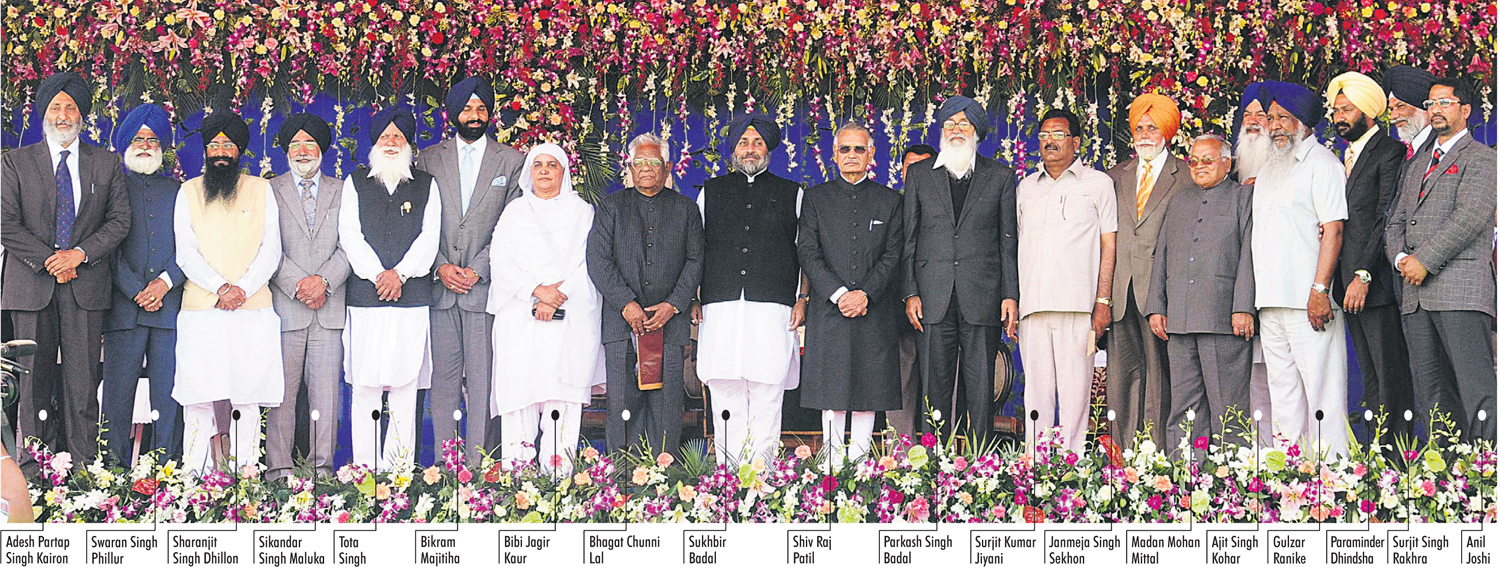
WARNING: This is long!
Last week, the Punjab election results surprised many. Most pundits had believed the cycle of anti-incumbency would continue and the Shiromani Akali Dal (Badal) would fall to the Congress Party, under Captain Amrinder Singh’s leadership. The results were stunning and after the final count the Akali Dal (56) combined with the BJP (12) had a majority (68) of the 117-member Punjab Legislative Assembly. The Congress Party had finished with a dismal 46 and 3 seats were claimed by Independents. The much-heralded (at least in the diaspora and on the internet) Punjab People’s Party of Manpreet Badal finished even worse than expected, with the main leader himself finishing in 3rd place in the two constituencies he contested.
Now the debate has shifted to making sense of the elections. In the diaspora, laments such as that of my fellow langa(w)riter decrying corruption and the social ills that have been broadcasted – farmer suicides, drug addiction, etc. Writers in Punjab, such as Yadvinder Curfew saw the victory not as that of the Akali Dal-BJP combine, but of a new ‘experiment’ by Sukhbir Badal and the shift in politics from issue based politics to one of media and money. The Badal family has control of both. Friends across social media spaces have provided their own analysis – from the business classes aligning with Sukhbir now that the populism of his father is dead [pagh salute @VehlaComrade] to swing voters, especially cash voters (aligning with the ruling AD-B) and ‘educated netizens’ (splitting between PPP and Congress) [pagh salute @askang – not the singer, mind you!] tilting votes in favor of the Akali Dal.
Now I get to add my voice. Hopefully in doing so, it will also help diasporic Sikhs and Punjabis understand the politics of Punjab and understand why seemingly irrational choices (those that everyone knows are corrupt) can still be rational.
I turn to political science explanations, although I am no political scientist, in order to help understand the results and the specificities of the politics of Punjab. I cite some of the most common explanations and offer some rambling comments, criticisms, and reflections. Hopefully in the comments section, you will add yours and we can have a great discussion.
Guest post by Nirbhau Kaur
[Admin note: This post was penned by the author the morning after election results were made public in Punjab.]
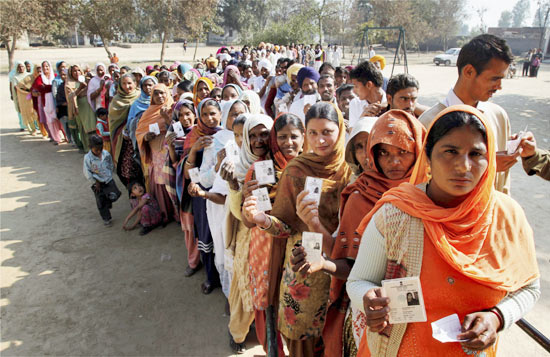 Pain. Disgust. Hurt. Dread. Longing. Connect, then Disconnect.
Pain. Disgust. Hurt. Dread. Longing. Connect, then Disconnect.
For the first time I felt these feelings in relation to Punjab – a land where I was not born, a land where I was not raised, a land that I didn’t truly experience until my early 20’s. Nonetheless, it is my father’s land, my Nana Ji’s land, my ancestors’ land. It is my land.
Today, there were countless social media updates reminding me of the five years of horror that Punjab is about to experience. For a small group of people, today was victorious. For a state full of people, today was just another reminder of their dark future. As the Badal family begins another five years of power in Punjab, the socially aware predict increased farmer suicides, increased drug and alcohol addictions, increased poverty. And the most grave prediction of them all, an end to Punjab, Punjabi, and Punjabiat.
Today, we express our disgust with the Badals and our sorrow for the future of Punjab. Not just today, but whenever there is an event to remember or increase awareness of any tragic situation in Punjab, be it farmer suicides or the despair in which the families of the shaheeds are surviving, we, as diasporic Punjabis, express deep sympathy. We speak of a need for change, we inspire, and we become inspired, but only in the appropriate setting. Shortly afterward, most of us move onto focus on our lives here, outside of Punjab.
In late 2009, we wrote a post about the growing number of homeless Punjabis and Sikhs living in Southall. Almost three years later, the situation in Southall continues to concern us. A recent article from the BBC discusses the plight of these young men who seek voluntarily deportation back to India but who, without documents, are unable to navigate an unforgiving bureaucratic situation.
Jagdeesh pulls away a piece of cardboard revealing a tiny hole in a concrete wall. He invites me to climb through, declaring: “This is my home, come in.”
“I was told that life was good here. It’s not just me, other boys came for work,” he says. “You can see what state we’re in, there’s no work, no government help.” Jagdeesh has cut himself off from his family, saying he is ashamed of his failure to find work and would rather they thought he was dead than knew he was living in filth. “They sold land and took out loans to get me out of India. What can I say to my family back home? The money we’ve invested is lost,” he says. [link]
According to figures from the UK Home Office, voluntary departures have risen steadily over the past few years, from 335 in 2005 to 15,537 in 2010. While many of these cases have been logged with the UK Border Agency, it seems that the Indian High Commission is dragging its feet on processing the cases. According to the article, the UK Border Agency admits that establishing the identity of illegal immigrants in order to issue them with emergency travel documentation is a “complex” process and that the time it takes to process these individuals varies by case. One individual, a man in his 30s, has been waiting for three years.
Many of these individuals abuse drugs and alcohol as a way to cope with the situation. Their thoughts often turn to suicide. Their only support system is each other and the majority of them haven’t even told their families, back in Punjab, about their broken dreams. It’s a difficult situation for these men – their lack of options in Punjab drives them to seek opportunities abroad but this promise of prosperity is not always what it seems to be.
As our UK co-blogger, Naujawani Sardar, states, “There are many questions being asked about the problems facing masses of illegal Punjabi immigrants in West London, but the most important questions that will prevent this situation from reoccurring in the long-term are not being asked: Why do so many youth risk everything to leave The Punjab? What is being done to curtail the agents that are facilitating their travel? And, what repercussions do UK citizens face for exploiting illegal immigrants?”
 Sikhs around the world will come together again to celebrate the Gurdgaddi of Guru Har Rai Ji again Sikh Vatavaran Diwas (environment day) for a second year in a row. On this day, Gurdwaras worldwide will focus kirtan and katha on the concept of kudrat, and participate in a number of hands on activities to protect our environment.
Sikhs around the world will come together again to celebrate the Gurdgaddi of Guru Har Rai Ji again Sikh Vatavaran Diwas (environment day) for a second year in a row. On this day, Gurdwaras worldwide will focus kirtan and katha on the concept of kudrat, and participate in a number of hands on activities to protect our environment.
Ask your Gurdwara to participate by:
- Focusing kirtan and katha on nature
- Hosting the Khalsa School Lesson on the Environment, created by the Sikh Research Institute
- Participating in a cleanup, tree planting, or children’s activity
All resources will be available on the EcoSikh website. Participating Gurdwaras should register to keep a database on worldwide activities, and respond with a ‘Yes’ on the Facebook invitation.
The purpose of Sikh Vatavaran Diwas is to bring Khalsa Panth together on issues of the environment. With Punjab ranking twenty-seventh out of thirty states in the environmental performance index (EPI), the need for Sikhs to connect Gurbani to the issues around them is real. The contamination of soil, land and water from intensive agricultural production remain high on the list of Punjab’s ecological challenges, in addition to industrial pollution and solid waste, low forest cover, and air pollution from thermal plants.
This video, part of a longer version produced for the Discovery Channel, invites viewers inside the Darbar Sahib in Amritsar [via Gurumustuk Singh]. It’s a rare opportunity to see some remarkable moments inside the complex and apparently this is the first time it has been televised. I believe it was recently shown in India and will be shown worldwide soon.
Some thoughts after the jump…
While most focus on Al-Jazeera’s coverage of the Middle East for its importance in today’s media landscape, slowly their incisive programs and documentaries have gained an audience amongst those serious about global issues throughout the world. I am a huge fan of their English service and can spend hours on end viewing some of their programming.
One of their recent series Slavery: A 21st Century Evil looks at this horrific practice. While our history books supposedly celebrate the end of the Atlantic Slave trade in the 19th century as the culmination in this most inhumane of all practices, this series belies such a facile narrative. They have documented sex slaves in Moldova, food chain slaves in the US, child slaves in Haiti, and charcoal slaves in Brazil. This week they turn towards bonded slavery in West Punjab.

The ubiquitous kilns of the Punjabi countryside are not only found on the west side of the border, but very much on the east side as well. I have extended family members that own such businesses, but have not considered what may be the labour situation governing there. The topics in the film even overlap with my own experiences in the diaspora. One too many uncles that I have known personally have traveled to Lahore, replete with their made-in-Amrika dollars, in order to purchase a replacement kidney for their years of alcohol abuse. I hope our Langa(r)eaders find time over the weekend to watch this touching episode and am interested to hear their own stories and thoughts on the issue.
To view the entire program – click here!
Beginning on October 15th, a three-day exhibition was held in Ludhiana to profile a generation of rising young artists in Punjab. The mission according to gallery is ‘to further enrich and diversify cultural life in the Punjab region by facilitating the development of emerging artists.’ The newly constructed gallery in Ludhiana offers exhibition and installation space, leads and collaborates in the development of programs for the visual and performing arts, and will soon be providing an art residency.
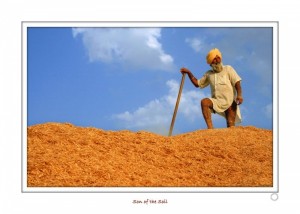 A recent exhibit called ‘Three/One: A Collaborative Art Exhibition in Ludhiana’ was held to showcase the work of Rachna Sidhu, Ankur Singh Patar, and Vivek Pandher, children of some of the most famous literary figures in Punjab. Rachna Sidhu, daughter of the famous thinker and literary critic Amarjit Grewal is a portrait maker at Guru Nanak International public school. Vivek Pandher is the son of the poetic genius Jaswant Zafar, a photographer by profession and a student of film production at UBC. Finally Ankur Singh Patar is son of poetic legend Surjit Patar and focuses on digital art, drawing much of his inspiration from his father’s literary treasures.
A recent exhibit called ‘Three/One: A Collaborative Art Exhibition in Ludhiana’ was held to showcase the work of Rachna Sidhu, Ankur Singh Patar, and Vivek Pandher, children of some of the most famous literary figures in Punjab. Rachna Sidhu, daughter of the famous thinker and literary critic Amarjit Grewal is a portrait maker at Guru Nanak International public school. Vivek Pandher is the son of the poetic genius Jaswant Zafar, a photographer by profession and a student of film production at UBC. Finally Ankur Singh Patar is son of poetic legend Surjit Patar and focuses on digital art, drawing much of his inspiration from his father’s literary treasures.


